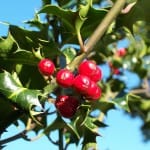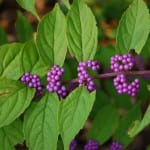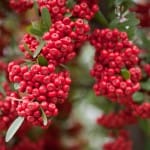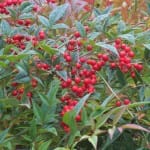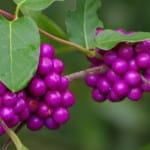Source(s): Jim Midcap, Extension Horticulturist, The University of Georgia College of Agricultural and Environmental Sciences.
The bright leaves of fall too soon discolor and drop, leaving bare stems. But then we discover the clusters of jewels still hidden among the plants. The ornamental fruit and berry season is upon us. Bright reds, oranges, yellows, purples and whites suddenly jump to the forefront.
Beautyberries
Among the most delightful of these appearances is the stunning purple fruit of the beautyberry. Our native American beautyberry produces dense clusters of lavender-purple fruit at every leaf at the ends of the stems. Long, arching branches are covered with leaves and fruit. And as soon as the leaves drop, the spectacular fruit is exposed.
American beautyberry grows 4 to 6 feet tall or higher and has coarse foliage and rank growth. Oriental beautyberries have smaller leaves, fruit and growth habit. All can be cut back heavily in early spring and still produce berries.
Plant beautyberries in full sun and well-drained soil for good growth and heavy fruit set. There are selections that produce white fruit. The white-fruited types are attractive early, but they discolor and lose their charm long before the purple-fruited types do. All can be used indoors as cut stems in flower arrangements.
Hollies
The hollies are the aristocrats of the fall berry producers.
Burford and Foster’s holly produce bright red fruits all over the plants. The contrast of the dark green foliage and bright red berries makes a perfect show. Burford holly develops into a 15- to 20-foot, rounded tree, while Foster’s holly is pyramidal and reaches 40 feet tall. Dwarf Burford is smaller in size, leaf and fruit, yet still reaches 10 feet tall.
Other evergreen hollies with attractive fruit include Savannah, Emily Brunner, yaupon and Mary Nell. The yaupon hollies have bright, translucent fruit. The selection, “Shadow’s Female,” is covered with lustrous, dark green leaves and masses of bright red fruit in fall.
Deciduous hollies
The deciduous hollies, possum haw and winterberry, can be spectacular, with bare branches loaded with red or orange berries. Winter Red winterberry holds its large red fruit the longest. Like most hollies, a male pollinator is needed for fruit set.
Many yellow-fruited hollies could brighten up our landscapes. The Chinese holly, “D’Or,” looks like a Burford with gleaming yellow berries. Some yaupon hollies also have yellow fruit. Yellow fruits often last late into the season because the birds don’t see them and they remain uneaten.
Pyracantha
Many other plants can add colorful fruit to our landscapes, too. The pyracantha or firethorn are spectacular when espaliered on a wall and covered with dark red or bright orange berries.
Nandina
Our tall nandina provides shining red berries against the evergreen foliage. Long canes covered with colorful berries can be cut and used in winter decorations without harming the plant. These fall and winter-berried plants add a sparkle to the garden just when we were ready to settle in for the winter.
Resource(s): Landscape Plants for Georgia
Center Publication Number: 154
- Fall Perfect for Planting Trees - September 24, 2013
- Fall Berry Color - September 24, 2013
- Discover the Hydrangeas - September 23, 2013
